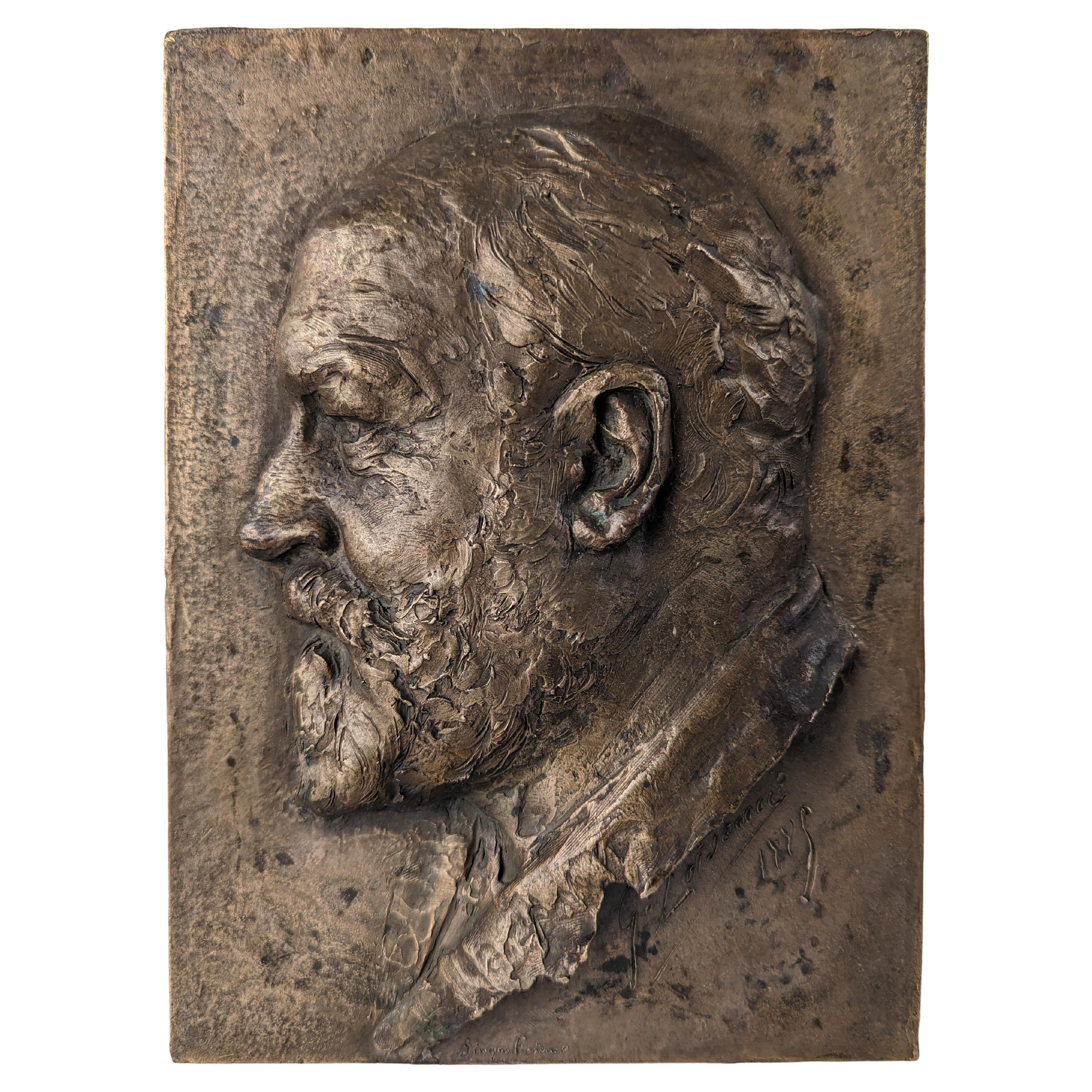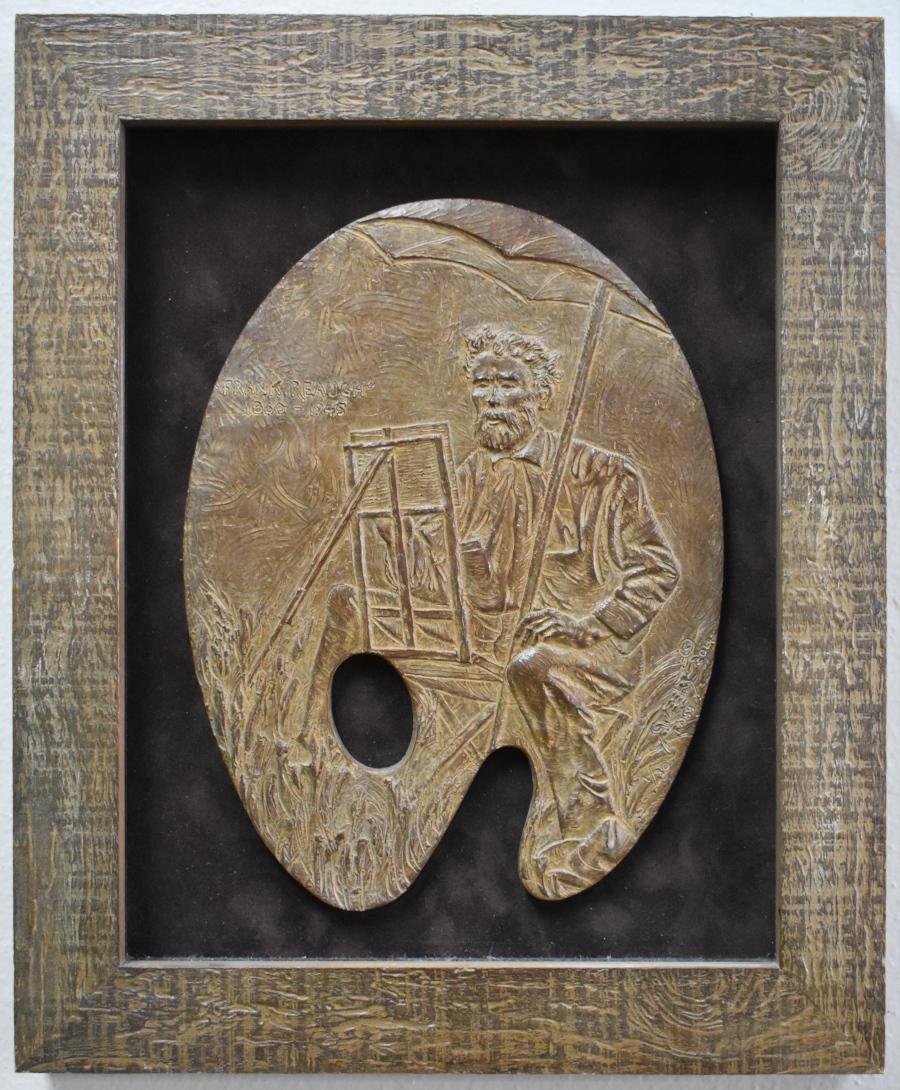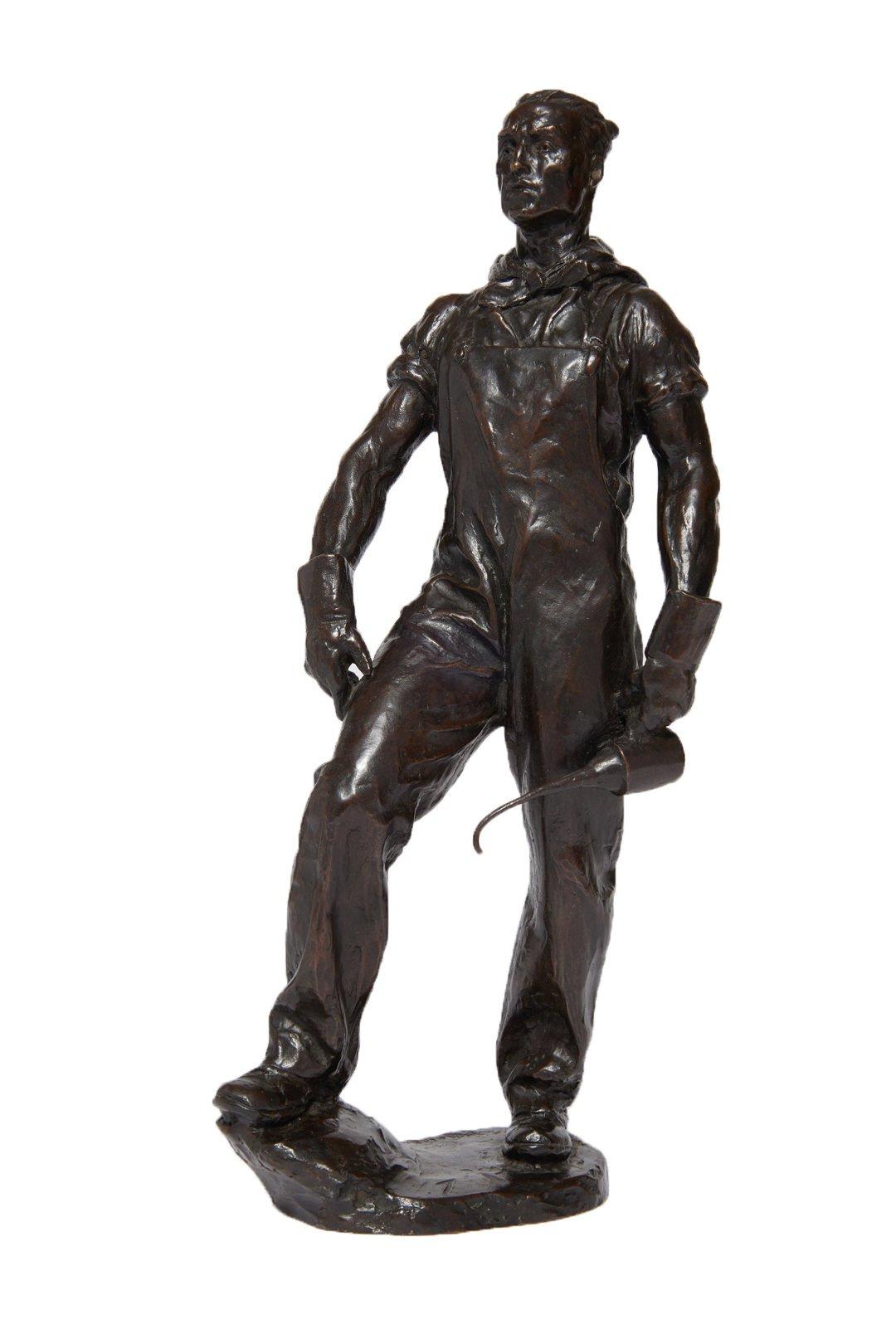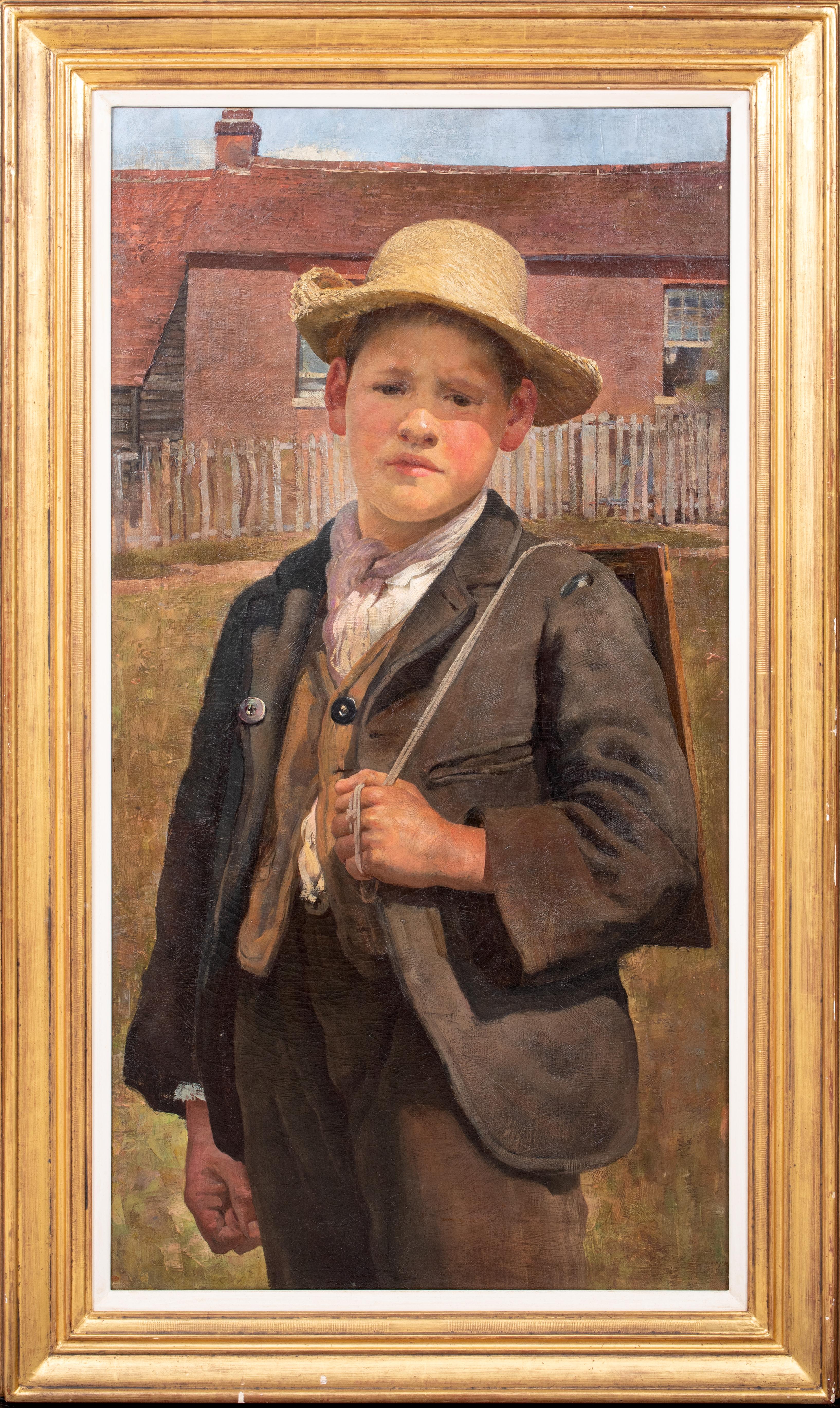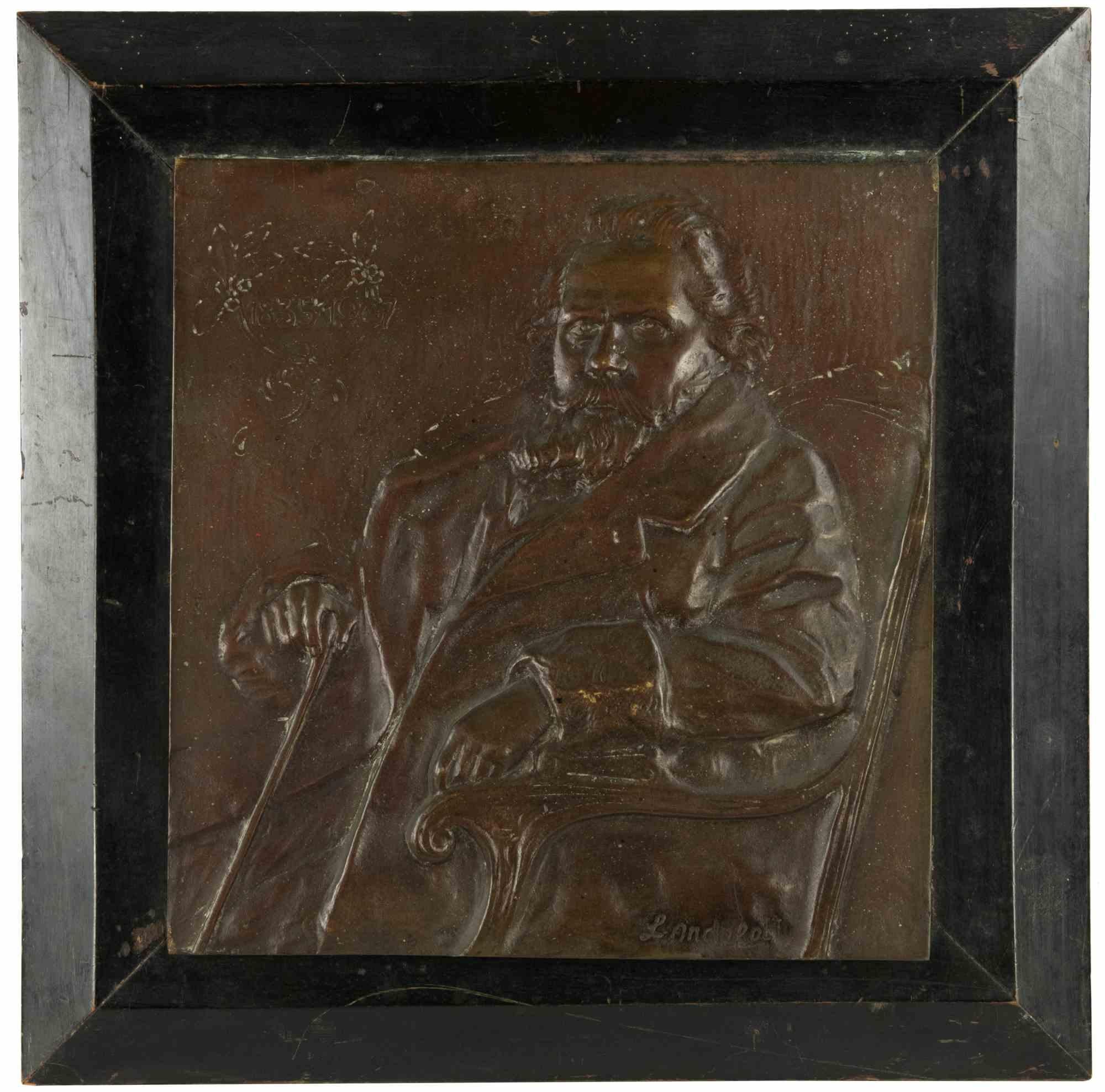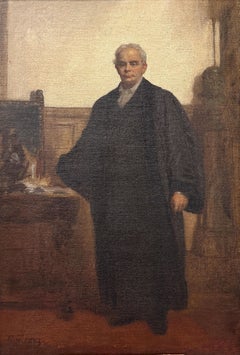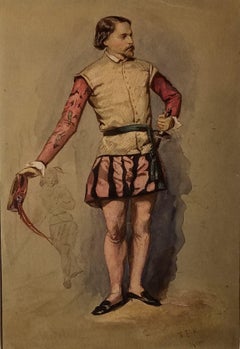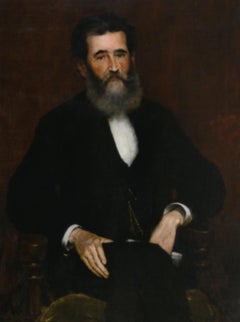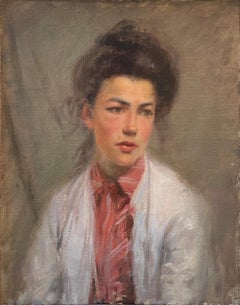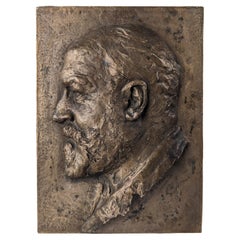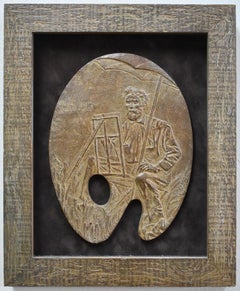Items Similar to "Jules Bastien LePage" Augustus Saint-Gaudens, Bas Relief of French Painter
Want more images or videos?
Request additional images or videos from the seller
1 of 3
Augustus Saint-Gaudens"Jules Bastien LePage" Augustus Saint-Gaudens, Bas Relief of French Painter
$18,000
£13,445.14
€15,587.49
CA$24,992.55
A$28,013.43
CHF 14,585.77
MX$342,055.98
NOK 185,186.30
SEK 175,539.96
DKK 116,299.58
Shipping
Retrieving quote...The 1stDibs Promise:
Authenticity Guarantee,
Money-Back Guarantee,
24-Hour Cancellation
About the Item
Augustus Saint-Gaudens
Jules Bastien LePage
Bronze
14 1/4 x 10 1/8 inches
Augustus Saint-Gaudens was born in 1848 in Dublin, Ireland. His father, Bernard, was a shoemaker from Aspet in Gascony, France, who married an Irishwoman, Mary McGuiness. A few months after Augustus' birth, the family emigrated to the United States to escape the famine, settling in New York City. In 1861 Augustus began his apprenticeships to French cameo cutters in New York, first in the studio of Louis Avet and later, in 1864, with Jules Le Brethon. He also attended classes at the National Academy of Design and the Cooper Union. Early in 1867, with his parents' backing, Saint-Gaudens embarked for Paris. Supporting himself as a cameo cutter, he studied first at the Ecole gratuite de Dessin (Petite Ecole) and, beginning in 1868, in the atelier of the sculptor François Jouffroy (1806-1882), who recommended his admission to the Ecole des Beaux-Arts. Saint-Gaudens became one of the first Americans to study sculpture at the Ecole.
In November of 1870, the Franco-Prussian War prompted Saint-Gaudens to move to Rome, where he began modeling Hiawatha (marble, 1874-1875; private collection) and made cameos and busts of American visitors. With assistance from one patron, Montgomery Gibbs, he returned to New York in September 1872 and began work on trademark panels for the Adams Express Building in Chicago. He taught his younger brother Louis (1854-1913) cameo cutting, and the two went to Rome together in 1873. Augustus modeled a number of portrait busts and copies after the antique, produced in marble in collaboration with Louis and other assistants. But he was above all a modeler whose greatest achievements would be realized in bronze. In 1874 he became engaged to Augusta Homer, who was in Rome studying painting.
Seeking commissions that would provide security for his marriage, Saint-Gaudens returned to New York in 1875, where he designed ornamental metalwork for Tiffany Studios. Around that time he met the painter John LaFarge (1835-1910) and the architects Stanford White (1854-1906) and Charles McKim (1847-1909), who became life-long friends and collaborators. La Farge encouraged Saint-Gaudens to try modeling portrait reliefs and to seek the commission for a monument to Admiral Farragut planned for Madison Square Park. He secured the Farragut commission in 1876. In 1876-1877 he also obtained commissions for tombs and monuments and, with La Farge's help and collaboration, for the reredos for Saint Thomas' Church (polychrome cement composition relief panels, 1877; destroyed by fire in 1905). After a sketch of his was rejected for the National Academy of Design exhibition, Saint-Gaudens joined Richard and Helena Gilder and others in founding the Society of American Artists. He finally married Augusta Homer on 4 June 4 1877; they left for Paris two days later.
In Paris Saint-Gaudens began modeling the portraits in low relief, which would become a leitmotiv of his career, and worked on the Farragut Monument. Stanford White, who came to live with the newlyweds, collaborated on designs for the base, the first of many such projects. With its allusions to Donatello's Saint George (c. 1416-1417, Florence, Museo Nazionale del Bargello), the Farragut Monument evoked the style of the Italian Renaissance as well as the French Ecole des Beaux-Arts, spurning the neo-classicism that had prevailed in American monuments. It was completed in 1880, just as Saint-Gaudens' son Homer (1880-1958) was born, and unveiled in 1881. Its quality and innovative character won Saint-Gaudens his first great public success.
Numerous commissions followed in the 1880s and 1890s. These included two major interior decorative projects for New York mansions between 1881 and 1883: the home of Cornelius Vanderbilt II (mantelpiece preserved in the Metropolitan Museum of Art, New York) and the Henry Villard House. The latter was designed by McKim, Mead, and White, with sculpture executed by Louis Saint-Gaudens under his brother's direction. Monument commissions included The Puritan for Merrick Park in Springfield, Massachusetts (1883-1886), and the standing statue of Abraham Lincoln for Lincoln Park, Chicago (1884-1887). An eighteen-foot statue of a nude Diana (1886-1891), made of gilded sheet copper to stand as a weather vane atop Stanford White's Madison Square Garden, proved too large and was replaced by a thirteen-foot version (1892-1894, Philadelphia Museum of Art). Simultaneously he worked on his most celebrated funerary monument, the Adams Memorial (1886-1891, Rock Creek Cemetery, Washington, D.C.), designed by Stanford White. The heavily veiled, seated figure, with its shadowed, introspective face, summons myriad emotions only beginning with grief for Marion Adams, the wife of historian Henry Adams, who committed suicide in 1885.
Diana and the Adams Memorial statues, at opposite ends of the expressive spectrum, share an ideal of beauty that came to life for the sculptor in his model Davida Johnson Clark, who became his mistress in the early 1880s, and bore him a son, Louis P. Clark, in 1889. Aside from Diana, works that are generally recognized as portraits of Davida include the much-admired Amor Caritas, an entranced, standing winged woman in richly modeled drapery, executed in variously sized bronze high reliefs, beginning in 1898. This figure was evidently conceived around 1880 for the tomb of Edward D. Morgan (unfinished, models destroyed), employed for the Vanderbilt mantelpiece caryatids in 1881-1883, and perfected on the tomb of Anna Maria Smith (1897, Newport, Rhode Island; signed by Louis Saint-Gaudens).
Arguably Saint-Gaudens' masterpiece is the Shaw Memorial on Boston Common, in progress from 1884 to 1897, combining statuary and high relief in bronze. It commemorates the young Colonel Robert Gould Shaw and the regiment of African-American volunteers who died in great numbers with him in a heroic assault on Fort Wagner, South Carolina, in 1863. Saint-Gaudens' gifts for portraiture, cadenced composition, and reserved expression calling forth projected emotions make this an exceptionally powerful war memorial. His last great public commission was the Sherman Monument of 1892-1903 on Grand Army Plaza in Central Park, New York, with a statue of General William Tecumseh Sherman on horseback led forward by a winged Victory.
In his peripatetic career Saint-Gaudens shuttled between Paris, Rome, his New York studio, and the one at his country estate of Aspet, in Cornish, New Hampshire, which was purchased in 1891 and named for the French town where his father was born. Diagnosed with cancer in 1900, he continued working with the help of assistants, recovering from a disastrous studio fire in 1904 and persevering until his death in Cornish in 1907. His late productions included the Stevenson Memorial of 1902 for Saint Giles' Cathedral, Edinburgh, incorporating a version of the famous portrait relief of Robert Louis Stevenson that he had modeled in 1887. In 1905-1907 he designed a new classical coinage for the United States mint, including ten-dollar and twenty-dollar gold pieces.
- Creator:Augustus Saint-Gaudens (1848 - 1907, American)
- Dimensions:Height: 14.25 in (36.2 cm)Width: 10.125 in (25.72 cm)
- Medium:
- Movement & Style:
- Period:
- Condition:
- Gallery Location:New York, NY
- Reference Number:1stDibs: LU1841215173022
About the Seller
5.0
Platinum Seller
Premium sellers with a 4.7+ rating and 24-hour response times
Established in 2022
1stDibs seller since 2022
108 sales on 1stDibs
Typical response time: <1 hour
- ShippingRetrieving quote...Shipping from: New York, NY
- Return Policy
Authenticity Guarantee
In the unlikely event there’s an issue with an item’s authenticity, contact us within 1 year for a full refund. DetailsMoney-Back Guarantee
If your item is not as described, is damaged in transit, or does not arrive, contact us within 7 days for a full refund. Details24-Hour Cancellation
You have a 24-hour grace period in which to reconsider your purchase, with no questions asked.Vetted Professional Sellers
Our world-class sellers must adhere to strict standards for service and quality, maintaining the integrity of our listings.Price-Match Guarantee
If you find that a seller listed the same item for a lower price elsewhere, we’ll match it.Trusted Global Delivery
Our best-in-class carrier network provides specialized shipping options worldwide, including custom delivery.More From This Seller
View All"John Van Schaick Lansing Pruyn" Eastman Johnson, Prominent Gentleman Portrait
By Eastman Johnson
Located in New York, NY
Eastman Johnson
John Van Schaick Lansing Pruyn, 1883
Initialed and dated lower left
Oil on canvas
28 x 18 inches
For many years the foremost genre painter in the United States, Eas...
Category
1880s Academic Figurative Paintings
Materials
Canvas, Oil
"Portrait of an Italian Fencer, " John Frederick Kensett, Hudson River School
By John Frederick Kensett
Located in New York, NY
John Frederick Kensett (1816 - 1872)
Portrait of an Italian Fencer, circa 1845-47
Watercolor on wove paper
13 1/8 x 8 1/8 inches
Signed with initials and inscribed lower right "J.F.K. Rome"
From October 1845 through the spring of 1847, Kensett lived in Rome. He attended classes where he sketched from live models, and he sketched in the countryside outside Rome and around Florence, Perugia, and Venice, places he visited with his artist friends. He fulfilled commissions for paintings from Americans in Italy, and by 1847 his career was well established.
Son of an English immigrant engraver, John Kensett lacked enthusiasm for that medium and became one of the most accomplished painters of the second generation of Hudson River School painters. His reputation is for Luminism, careful depiction of light, weather, and atmosphere as they affect color and texture of natural forms. He was particularly influenced by the painting of Asher Durand in that he focused on realism and detail rather than the highly dramatic views associated with Thomas Cole. Going to the western United States in the mid 1850s and the 1860s, he was the first of the Hudson River School painters to explore and paint the West.
Kensett was born and raised in Cheshire, Connecticut, and learned his engraving from his father, Thomas Kensett with whom he worked in New Haven, Connecticut until 1829. He continued working until 1840 as an engraver of labels, banknotes and maps and was employed part of that time by the American Bank Note Company in New York City. There he met Thomas Rossiter, John Casilear, and other artists who urged him to pursue painting. In 1840, he and Rossiter, Asher Durand, and Casilear went to Europe where Kensett stayed for seven years and supported himself by doing engraving but became accomplished in landscape painting.
Having sent canvases of Italian landscapes back to New York, he had a reputation for skillful painting that preceded him. When he returned to New York City in 1847, he was an "instant success" and very sought after by collectors. Two of his Italian landscapes had already been purchased by the American Art Union. By 1849, he was a full member of the National Academy of Design and was generally popular among his peers. His studio was a gathering place with travelers stopping by to see his canvases and to identify "precise locations in the Catskills or Newport or New England in the oil sketches and drawings that covered his walls." (Zellman 170). For the women, he was a popular bachelor, "romantic looking with high forehead and sensitive expression." (Samuels 262)
He was also sought after by many organizations. Among his activities were serving on the committee to oversee the decoration of the United States Capitol in Washington DC, and becoming one of the founders of the Metropolitan Museum in New York.
An inveterate traveler, Kensett spent summers on painting excursions away from New York City. One of these trips was a special painting excursion with fifteen other artists sponsored by the B & O Railroad from Baltimore, Maryland to Wheeling, West Virginia. Unlike many of the Hudson River painters...
Category
1840s Hudson River School Figurative Paintings
Materials
Paper, Watercolor
"Portrait of Louis Prang" William Merritt Chase, Impressionist Portrait
By William Merritt Chase
Located in New York, NY
William Merritt Chase
Portrait of Louis Prang, 1884
Signed center right "WM M Chase"
Oil on canvas
41 1/2 x 30 1/2 inches
Provenance
The artist
Louis Prang
Gift from the sitter to R...
Category
1880s American Impressionist Figurative Paintings
Materials
Canvas, Oil
"Marion Jones Farquhar" Frederick William Macmonnies, Tennis Olympian Portrait
By Frederick William MacMonnies
Located in New York, NY
Frederick William Macmonnies
Marion Jones Farquhar, 1905-11
Oil on canvas
24 x 20 inches
Provenance:
William Clerk
Private Collection, New York
Literature:
Mary Smart, A Flight with Fame: The Life and Art of Frederick MacMonnies, with a Catalogue Raisonne of Sculpture and a Checklist of Paintings by E. Adina Gordon, Madison, Connecticut, 1996, no. 90.
The work depicts Marion Jones Farquhar who, was an American tennis player who competed during the late 19th century and early 20th century. She won the singles titles at the 1899 and 1902 U.S championships and was the first American woman to medal at the Olympics placing Bronze in singles. Additionally, she was the artist's sister-in-law who often played and competed with MacMonnies in golf and tennis. MacMonnies would often study the movements of her form referenced in his sculpture. When MacMonnies won a doubles golf tournament he said "Marion dragged my dead weight thro' and won us the tournament, showing what great Generalship can do."
A sculptor of classical figures, American-born Frederick MacMonnies had fame in the United States and Europe in the later half of the 19th century and early 20th century. He occasionally returned to America but lived most of his life as in expatriate in France. He was especially known for his lithe bronze figures, especially ones titled Diana. The classical names of these figures allowed him the appearance of propriety but gave him the opportunity to model svelte nudes.
Frederick MacMonnies was one of the first American sculptors to recognize the potential market of the middle class. He copyrighted his works and then contracted with foundries to mass produce some of his figures such as Diana in smaller sizes.
MacMonnies was born in Brooklyn, New York, and was a child prodigy at carving stone. At age 18, he worked in the studio of Augustus Saint-Gaudens, and then persuaded him to become his assistant, keeping models damp and covered, running errands, and cleaning the studio. Evenings he studied at the Art Students League, Cooper Union, and the National Academy of Design.
In Saint-Gaudens' studio, he met many of the wealthy people who shared Saint-Gaudens Beaux-Arts based ideas that art and architecture should be unified in order to create public art in America equal to that of classical antiquity or Renaissance Europe. Among the men that MacMonnies met through Saint-Gaudens who later furthered his career were architects Stanford White and Charles McKim...
Category
Early 1900s American Impressionist Portrait Paintings
Materials
Canvas, Oil
"Sudbourne Premier: Suffolk Punch Stallion" Herbert Haseltine, 1927 Bronze
Located in New York, NY
Herbert Haseltine
Sudbourne Premier: Suffolk Punch Stallion, 1927
Signed left side: © HASELTINE / MCMXXVII
Bronze, dark brown patina, parcel gilding
...
Category
1920s Realist Figurative Sculptures
Materials
Bronze
"The Guitarist" Louis Betts, 1920s Portrait American Impressionist Painting
By Louis Betts
Located in New York, NY
Louis Betts
The Guitarist, circa 1920
Signed upper left
Oil on canvas
27 x 18 inches
Louis L. Betts was a painter active in the first half of the twentieth century in the United St...
Category
1920s American Impressionist Figurative Paintings
Materials
Canvas, Oil
You May Also Like
Portrait Bronze Relief Sculpture by G Loiseau, 1885
By Gustave Loiseau
Located in Benalmadena, ES
Magnificent relief work portraying a man made in bronze signed G Loiseau attributed to the great post-impressionist French artist Gustave Loiseau. This attribution is given by not kn...
Category
Antique 1880s French Figurative Sculptures
Materials
Bronze
$9,611 Sale Price
20% Off
"FRANK REAUGH" PALLET BRONZE DATED 2014 1/30 TEXAS ARTISTS, SCULPTOR & SUBJECT
Located in San Antonio, TX
Garland Weeks
(1942-Present)
Lubbock Artist
Image Size: 12 x 9
Frame Size: 17 x 14
Medium: Bronze
2014
"Frank Reaugh" Bronze Relief Pallet depicting Frank Reaugh at his easel.
Category
2010s Impressionist Figurative Sculptures
Materials
Bronze
Portrait of Albert Dubarry
Located in PARIS, FR
Portrait of Albert Dubarry
by Léon-Ernest DRIVIER (1878-1951)
Bronze with a nuanced greenish dark brown patina
signed "Drivier"
cast by "Montagutelli, Paris, cire perdue" (with the ...
Category
1930s French School Figurative Sculptures
Materials
Bronze
Locomotive Engineer, Early 20th Century Bronze Laborer, Cleveland School
By Max Kalish
Located in Beachwood, OH
Max Kalish (American, 1891-1945)
Locomotive Engineer, 1926
Bronze
Signed and dated on base, foundry mark: Meroni Radice Cire Perdue Paris
15.5 x 6 x 5 inches
Born in Poland March 1, 1891, figurative sculptor Max Kalish came to the United States in 1894, his family settling in Ohio. A talented youth, Kalish enrolled at the Cleveland Institute of Art as a fifteen-year-old, receiving a first-place award for modeling the figure during studies with Herman Matzen. Kalish went to New York City following graduation, studying with Isidore Konti and Herbert Adams...
Category
1920s Figurative Sculptures
Materials
Bronze
L'écolier, 19th Century - Jules Bastien-Lepage (1848-1884)
Located in Blackwater, GB
L'écolier, 19th Century
circle of Jules Bastien-Lepage (1848-1884)
Large 19th Century portrait of a young village school boy, oil on canvas circle of Jules Bastien-Lepage. Excell...
Category
Early 19th Century Portrait Paintings
Materials
Canvas, Oil
$10,585 Sale Price
20% Off
Portrait of Giosuè Carducci -Mixed Media by Libero Andreotti Early 20th Century
Located in Roma, IT
Portrait of Giosuè Carducci is an original modern artwork realized by Libero Andreotti in the first half of 20th century.
Relief on copper plate.
Includes frame.
Signature on the ...
Category
Early 20th Century Modern Figurative Sculptures
Materials
Copper
More Ways To Browse
French Relief
Antique Relief Sculpture
High Relief Sculpture
Antique Marble Relief
Antique Saints Sculptures
Bas Relief Sculptures
Tiffany Live
French Bas Relief
Antique Bas Relief
African American Antique
Marble Relief Sculpture
Antique Bronze Relief
Bronze Bas Relief
Italian Bas Relief
Dollars Gold
Sculptors Modeling Stand
Relief Bust
Bas Relief Gold
